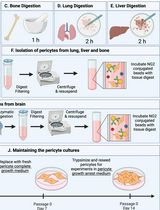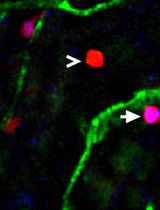- EN - English
- CN - 中文
The Chick Embryo Chorioallantoic Membrane as an in vivo Model to Study Metastasis
基于鸡胚绒毛尿囊膜的体内癌症转移模型
发布: 2016年10月20日第6卷第20期 DOI: 10.21769/BioProtoc.1962 浏览次数: 22662
评审: HongLok LungAnita UmeshAnonymous reviewer(s)
Abstract
Metastasis is a complex process that includes several steps: neoplastic progression, angiogenesis, cell migration and invasion, intravasation into nearby blood vessels, survival in the circulatory system, extravasation followed by homing into distant tissues, the formation of micrometastases, and finally the growth into macroscopic secondary tumors. This complexity makes metastases difficult to investigate and quantify in animal models. The chick embryo is a unique in vivo model that overcomes many limitations for studying the metastatic process, due to the accessibility of the chorioallantoic membrane (CAM), a well-vascularized extra-embryonic tissue located under the eggshell, that is receptive to the xenografting of mammalian tumor cells, including human. Since the chick embryo is naturally immunodeficient at this stage, the CAM can support the engraftment of tumor cells, and their growth therein can faithfully recapitulate most of the characteristics of the carcinogenic process including: growth, invasion, angiogenesis and colonization of distant tissues (Deryugina and Quigley, 2008; Zijlstra et al., 2002). The CAM sustains rapid tumor formation within 5-7 days after cancer cell grafting. This feature provides a unique experimental model for a rapid study of the intravasation and colonization steps of the metastatic cascade. Furthermore, using quantitative PCR to detect species-specific sequences, such as Alu, the chick embryo CAM model can be used to monitor and quantify the presence of the xenografted, ectopic tumor cells in distant tissues. Thus, the chick embryo model has proved a valuable tool for cancer research, in particular for the investigation of molecules and pathways involved in cancer metastasis and to analyze the response of metastatic cancer to potential therapies (Herrero et al., 2015; Casar et al., 2014). In this respect, the use of the rapid and quantitative spontaneous metastasis chick embryo model can provide an alternative approach to conventional mouse model systems for screening anti-cancer agents.
Keywords: Metastasis model (转移模型)Materials and Reagents
- 20 G needles (BD, PrecisionGlideTM, catalog number: 305175 )
- 30 G needles (BD, PrecisionGlideTM, catalog number: 305128 )
- MicroAmp® optical 96 well PCR plate (Thermo Fisher Scientific, Applied BiosystemsTM, catalog number: N8010560 )
- MicroAmp® optical adhesive film (Thermo Fisher Scientific, Applied BiosystemsTM, catalog number: 4311971 )
- Cotton tipped applicators, cotton swab, Iodine liquid (Thermo Fisher Scientific)
- Laboratory tape 1/2" x 500" (VWR, catalog number: 470144-262 )
- Fertilized chicken eggs (Gilbert farm, Tarragona, Spain)
- A375 melanoma cell line (ATCC, catalog number: CRL-1619 )
- SKMEL2 (ATCC, catalog number: HTB68 )
- RKO colorectal cancer cell line (ATCC, catalog number: CRL-2577 )
- HCT116 (ATCC, catalog number: CCL-247 )
- DEL 22379 (Vichem Chemie, Budapest)
- Trypsin 0.05% with EDTA (1 mM), liquid (Thermo Fisher Scientific, GibcoTM, catalog number: 25300-054 )
- Phosphate-buffered saline (PBS) (1x, pH 7.4), liquid (Thermo Fisher Scientific, GibcoTM, catalog number: 10010023 )
- Penicillin-streptomycin (10,000 U/ml) (Thermo Fisher Scientific, GibcoTM, catalog number: 15140122 )
- Dulbecco’s modified Eagle medium (DMEM) (Thermo Fisher Scientific, catalog number: 41965062 )
- Fetal bovine serum (Thermo Fisher Scientific, GibcoTM, catalog number: 10270-106 )
- QIA amp genomic DNA purification kit (QIAGEN, catalog number: 158906 ; 158910 ; 158914 )
- Primers (HPLC purification, IDT DNA technologies)
Alu (human) sense: 5’ ACGCCTGTAATCCCAGGACTT 3’
Alu (human) antisense: 5’ TCGCCCAGGCTGGCTGGGTGCA 3’
Chicken GAPDH sense: 5’ GAGGAAAGGTCGCCTGGTGGATCG 3’
Chicken GAPDH antisense: 5’ GGTGAGGACAAGCAGTGAGGA ACG 3’ - SYBR® green mix real time PCR (Thermo Fisher Scientific, Applied BiosystemsTM, catalog number: 4472908 )
Equipment
- Incubator 37 °C, 60% humidity (Thermo Fisher Scientific, Thermo ScientificTM, catalog number: 51028117 )
- Rotating eggs trays (automatic eggs turner) (GQF, catalog number: 1611 )
- Tugon tube (Drifton, model: Tygon LMT )
- Egg candler (Lyon, model: 950-170 )
- Microsurgical kits, sterile forceps, push pin, dissection scissors, needle nose forceps (VWR, IntegraTM Miltex®, catalog number: 95042-542 )
- Dremel 100 rotary tool (Dremel, model: 100N/7 )
- Dremel cut off wheels number 36 (Dremel)
- Hemocytometer, Neubauer chamber (EMD Millipore)
- 2-20 µl pipette (Eppendorf, Eppendorf Research®, catalog number: 3120000038 )
- 20-200 µl pipette (Eppendorf, Eppendorf Research®, catalog number: 3120000054 )
- Automatic pipette (Eppendorf, Eppendorf Easypet® 3, catalog number: 4430000018 )
- Real time PCR instrument (Thermo Fisher Scientific, Applied BiosystemsTM, model: StepOne plus RT PCR )
Software
- Graph Pad Prism software
Procedure
文章信息
版权信息
© 2016 The Authors; exclusive licensee Bio-protocol LLC.
如何引用
Crespo, P. and Casar, B. (2016). The Chick Embryo Chorioallantoic Membrane as an in vivo Model to Study Metastasis. Bio-protocol 6(20): e1962. DOI: 10.21769/BioProtoc.1962.
分类
癌症生物学 > 侵袭和转移 > 细胞生物学试验
细胞生物学 > 细胞运动 > 细胞迁移
您对这篇实验方法有问题吗?
在此处发布您的问题,我们将邀请本文作者来回答。同时,我们会将您的问题发布到Bio-protocol Exchange,以便寻求社区成员的帮助。
Share
Bluesky
X
Copy link














